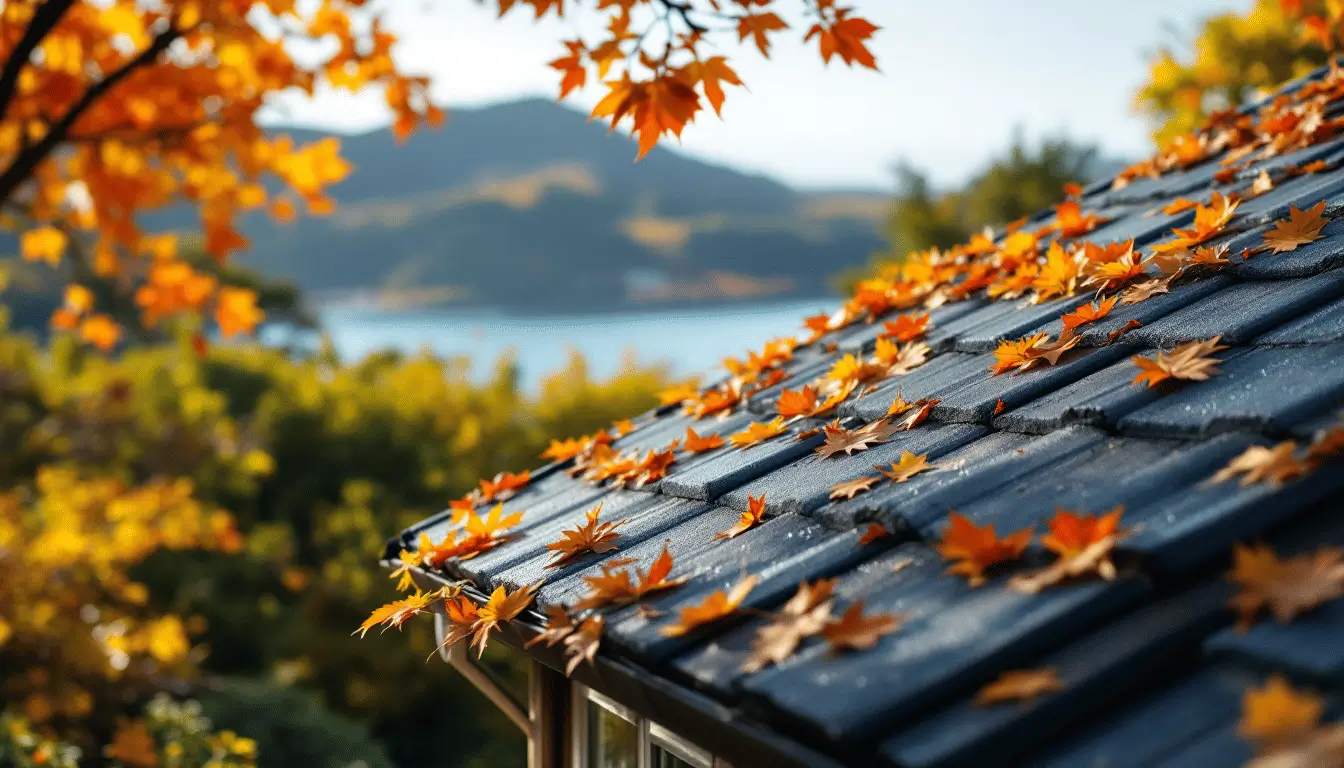
Your roof is your home’s first line of defence against New Zealand’s sometimes harsh weather conditions. But like any protective barrier, it needs regular check-ups to ensure it’s doing its job properly. As we head into autumn 2025, now is the perfect time to schedule that roof inspection you’ve been putting off. The best part? A Roof Inspection with Rockstar Roofing is 100% FREE! So here’s why you shouldn’t wait until winter arrives.
Key Takeaways
- Autumn provides optimal conditions for thorough roof inspections before winter weather hits New Zealand.
- Identifying small issues now prevents costly emergency repairs later.
- Summer heat and UV exposure can cause significant roof damage that becomes evident by autumn.
- A proper autumn inspection ensures your roof is ready to handle New Zealand’s winter rainfall and winds.
- Trained roof inspectors can spot potential problems that homeowners might miss.
- Sloped roofs excel in areas with heavy rainfall or snow
- Knowing your roof is sound before winter arrives provides valuable security for you and your family.
Why Autumn Is Ideal for Roof Inspections
Autumn in New Zealand brings milder temperatures and (usually) less rainfall than winter months. This weather sweet spot creates ideal conditions for thorough roof inspections. The summer heat has passed, meaning roofing materials aren’t expanding in high temperatures, giving you a more accurate assessment of your roof’s condition.

After the hot summer months, your roof may have experienced:
- UV damage from intense sunlight
- Expansion and contraction of roofing materials
- Potential storm damage from summer weather systems
- Growth of moss or lichen in humid conditions
By autumn, these issues become more visible and easier for professionals to identify.
Signs Your Roof Needs Attention
Not sure if your roof needs an inspection? Here are some telltale signs that shouldn’t be ignored:
- Missing or damaged shingles/tiles: Gaps in your roof’s coverage are an open invitation for water to enter.
- Sagging areas: This could indicate structural issues that need immediate attention.
- Water stains on ceilings or walls: If water’s getting in, you’ve already got a problem.
- Increased energy bills: Poor roof condition can affect your home’s insulation efficiency.
- Granules in gutters: For shingle roofs, this suggests deterioration.
- Daylight visible through roof boards: Check your attic for any rays of light coming through.
The Consequences of Delaying Roof Maintenance
Putting off roof inspections might save you a few dollars now, but could cost you thousands in the long run. Here’s what you risk by waiting:

Water Damage
Once water breaches your roof’s defences, it can cause extensive damage to your ceiling, walls, insulation, and even your home’s structural integrity. Autumn in New Zealand is typically when rainfall begins to increase, making it crucial to identify and fix any vulnerabilities before the winter downpours.
Mould and Mildew
New Zealand’s climate can be particularly conducive to mould growth. Once moisture enters your home through roof leaks, mould can develop within 24-48 hours. This not only damages your property but can also impact your family’s health.
Increased Energy Costs
A compromised roof means your heating system will need to work harder during the coming winter months. Small issues identified in autumn can help you avoid the higher energy bills that come with a poorly insulated or damaged roof.
Reduced Property Value
If you’re considering selling your home in the future, a well-maintained roof is a significant selling point. Prospective buyers are likely to negotiate harder or walk away entirely if they spot roof issues during their inspection.
Preparing Your Roof for Winter 2025
Winter in New Zealand brings its own set of challenges for roofing. Heavy rainfall, strong winds, and in some regions, snow and ice, all test your roof’s integrity. An autumn inspection ensures you’re prepared for whatever winter throws at you.
Our professional inspections include:
- Checking for loose or damaged roofing materials
- Examining flashing around chimneys, vents, and skylights
- Assessing gutter systems for blockages or damage
- Inspecting the underside of your roof from the attic
- Looking for signs of water intrusion or structural issues
- Evaluating the condition of roof ventilation systems
Not all roof inspections are created equal. Our team at Rockstar Roofing brings years of experience specific to New Zealand roofing types and weather conditions. We understand the unique challenges that Kiwi homeowners face, from the coastal salt spray in Paraparaumu and the Kapiti Coast to the windy conditions in Wellington.

Our thorough inspection process doesn’t just identify current problems, it spots potential issues before they become costly repairs. We provide clear, jargon-free reports so you understand exactly what’s happening with your roof. If you would like peace of mind on a regular basis, sign up for our Roof Care Program. This is exclusive to your roof and we will visit you annually for one fixed cost of $299 to assess and maintain your home’ roof. This catches any major issues early saving you money, and worry, down the road.
Conclusion: Don’t Wait Until It’s Too Late.
The best time to address roof issues is before they become emergencies. Autumn 2025 gives you the perfect opportunity to:
- Catch and repair summer damage
- Prepare for winter weather
- Plan and budget for any necessary work
- Ensure your family stays warm and dry all winter long
Remember, a stitch in time saves nine. Especially when it comes to your roof. Contact Rockstar Roofing today to schedule your 100% FREE autumn roof inspection and enjoy the peace of mind that comes with knowing your home is protected from top to bottom.
FAQ
How often should I have my roof inspected in New Zealand?
We recommend having your roof professionally inspected at least once a year, with autumn being the ideal time. However, if you’ve experienced severe weather events or your roof is over 15 years old, biannual inspections (autumn and spring) are advisable.
What does a professional roof inspection cost in New Zealand?
The cost with Rockstar Roofing is nothing, nada, zero. We feel it’s just good honest kiwi business! Should anything be discovered however, we offer highly competitive pricing with detailed reports included as standard to help you make a decision.
How long does a thorough roof inspection take?
Most residential roof inspections take between 45 minutes to 2 hours. The duration depends on your roof’s size, accessibility, and whether we find issues that require closer examination.
Can I inspect my roof myself instead of hiring professionals?
While a visual check from the ground or looking for interior water stains is helpful, professional inspectors have the training, equipment, and experience to safely access all roof areas and identify subtle problems that untrained eyes might miss.
What’s included in Rockstar Roofing’s inspection service?
Our comprehensive inspections include checking all roofing materials, flashing, gutters, downpipes, ridge caps, valleys, roof penetrations, attic ventilation, signs of leaks, structural integrity, and a detailed report with photos and recommendations.
If problems are found during an inspection, how quickly can repairs begin?
If we identify urgent issues during your autumn inspection, we can often perform minor repairs immediately. For more extensive work, we’ll provide a detailed quote and can typically schedule repairs within 1-3 weeks, ensuring your roof is ready before winter weather arrives.
How can I prepare my home for a roof inspection?
Clear access to your property, trim overhanging branches if possible, and ensure interior access to your attic or ceiling space if you have one. It’s also helpful to note any concerns or recent issues you’ve noticed with your roof.
Are there specific roofing issues unique to New Zealand homes?
Yes, New Zealand’s diverse climate presents unique challenges. Coastal properties face salt corrosion, while homes in rainy regions like Wellington deal with persistent moisture issues. Older kiwi homes with corrugated iron roofing often need specialized attention to flashing and fixings.
How long can I expect my roof to last in New Zealand conditions?
Depending on the materials, proper installation, and maintenance, most roofing systems in New Zealand last 20-50 years. Concrete tiles typically last 50+ years, metal roofing 30-70 years, and asphalt shingles 15-30 years. Regular inspections can help maximise your roof’s lifespan.
What happens if I wait until winter to address roofing issues?
Winter repairs are often more difficult, expensive, and time-consuming due to weather constraints. Roofers may have limited working days due to rain, repairs might take longer to complete, and existing problems could worsen due to additional water exposure during delays.
Source Links
- Different Types of Roof Construction – https://rockstarroofing.co.nz/different-types-of-roof-construction/
- Common Roof Problems in New Zealand – https://rockstarroofing.co.nz/common-roof-problems-new-zealand/
- Professional Roof Inspection Services – https://rockstarroofing.co.nz/services/roof-inspections/
- How to Extend the Life of Your Roof – https://rockstarroofing.co.nz/extend-roof-lifespan/
- Seasonal Weather Patterns in New Zealand – https://niwa.co.nz/education-and-training/schools/resources/climate/seasonalclimate
- Home Maintenance Guide for New Zealand Homeowners – https://www.buildersnz.co.nz/homeowners/maintenance-guide
- Signs of Water Damage in Your Home – https://rockstarroofing.co.nz/signs-of-water-damage/
- Energy Efficiency Through Proper Roofing – https://www.energywise.govt.nz/at-home/insulation/roof-and-ceiling-insulation/
- Roof Repair vs. Replacement: Making the Right Choice – https://rockstarroofing.co.nz/repair-vs-replacement/
- Auckland Climate and Weather Considerations for Roofing – https://rockstarroofing.co.nz/auckland-weather-roofing/

Comments are closed